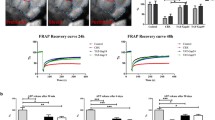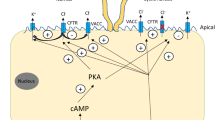Abstract.
Gap junction channels in the rodent liver are composed of connexin26 (Cx26) and connexin32 (Cx32) proteins. Gap junctional intercellular communication in the mouse liver enhances the effects of hormonal or sympathetic stimulation of glucose release from glycogen stores. To determine whether contraction of bile canaliculi and bile secretion are dependent on the function of gap junction channels, we compared wild-type and connexin32-deficient mice. Confocal laser scanning microscopy of the wild-type mouse liver confirmed the close association of connexin26 and -32 proteins with the zona occludens-1 protein and actin filaments of the bile canaliculi. The decrease of bile flow after electrical stimulation of sympathetic nerves in the perfused liver was attenuated in the Cx32-deficient liver compared with wild-type controls. The amount of secreted bile, however, was similar in wild-type and Cx32-deficient livers. Furthermore, Cx32-deficient mice exhibited dilated bile canaliculi, suggesting that the contraction of bile canaliculi could be impaired in these animals.
Similar content being viewed by others
Author information
Authors and Affiliations
Additional information
Electronic Publication
Rights and permissions
About this article
Cite this article
Temme, A., Stümpel, F., Söhl, G. et al. Dilated bile canaliculi and attenuated decrease of nerve-dependent bile secretion in connexin32-deficient mouse liver. Pflügers Arch - Eur J Physiol 442, 961–966 (2001). https://doi.org/10.1007/s004240100623
Received:
Accepted:
Issue Date:
DOI: https://doi.org/10.1007/s004240100623




